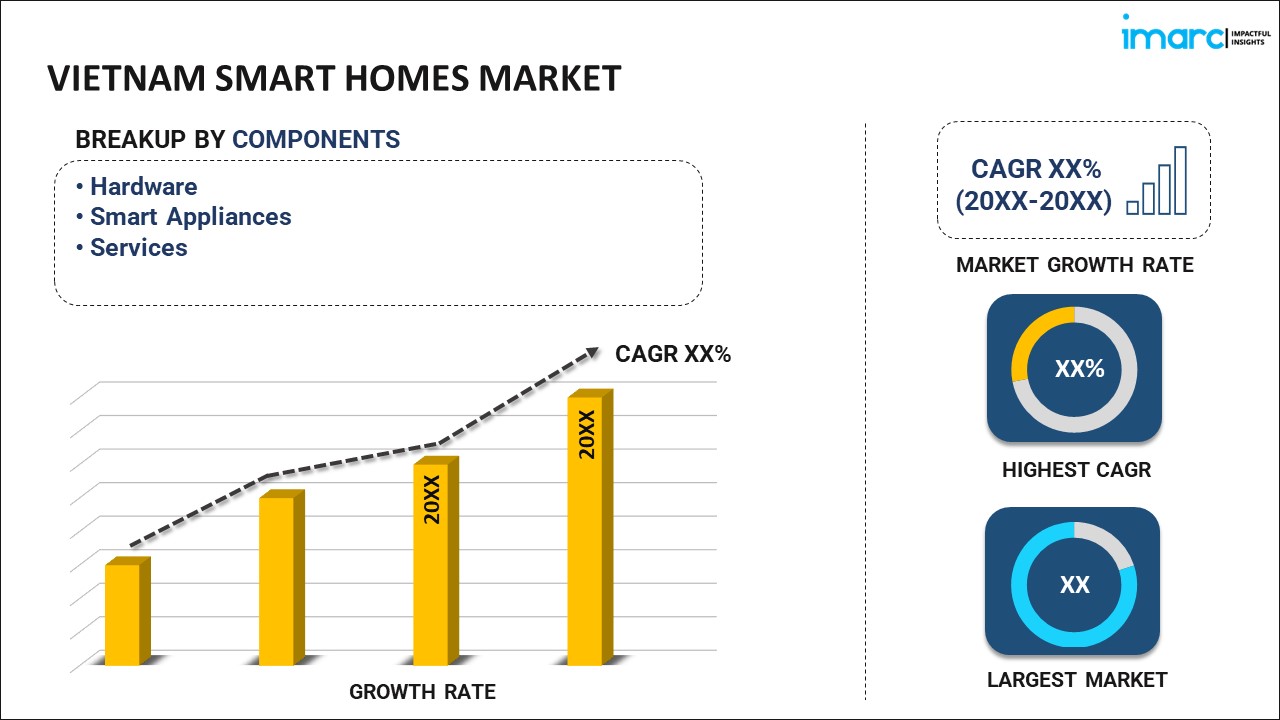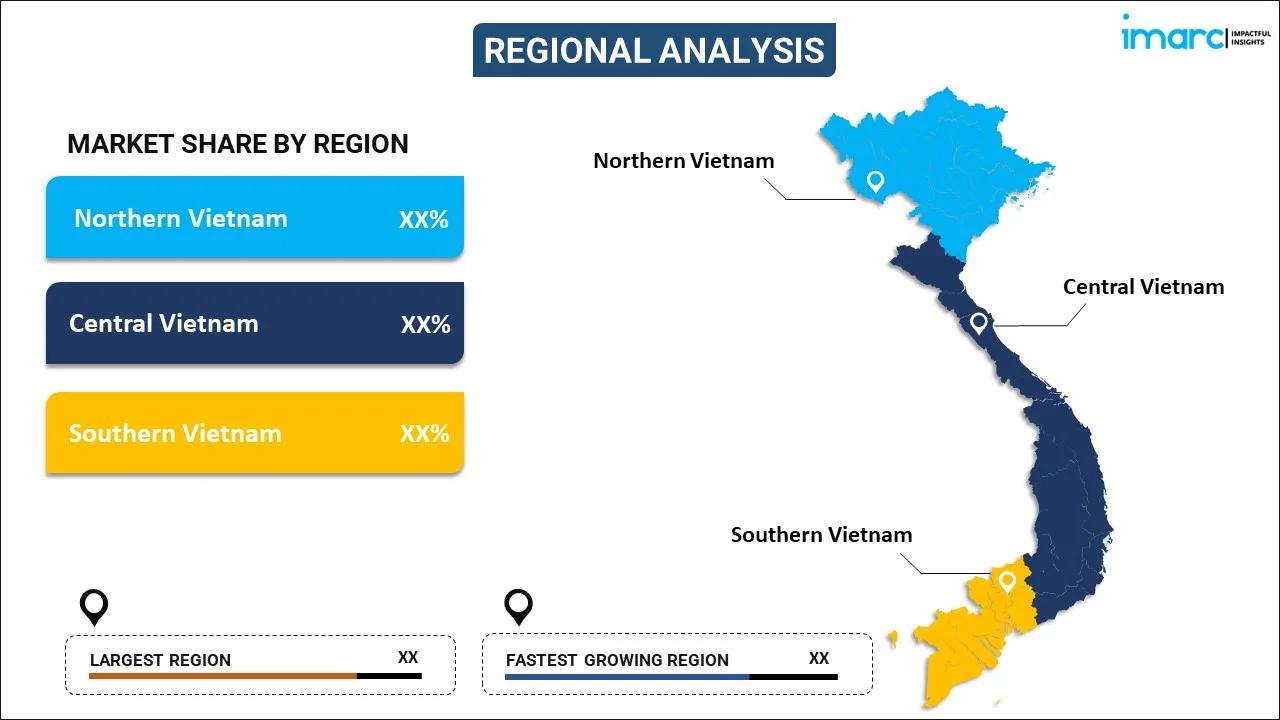
Vietnam Smart Homes Market Report by Component (Hardware, Smart Appliances, Services), Application (Security and Surveillance, Lighting, Entertainment, Energy Management, HVAC, Smart Kitchen, Home Fitness and Wellness), and Region 2025-2033
Market Overview:
Vietnam smart homes market size reached USD 692.1 Million in 2024. Looking forward, IMARC Group expects the market to reach USD 1,708.0 Million by 2033, exhibiting a growth rate (CAGR) of 9.20% during 2025-2033. The rising demand for automated and convenient living and the continuous advancements in voice recognition technologies are primarily driving the market growth.
|
Report Attribute
|
Key Statistics
|
|---|---|
|
Base Year
|
2024
|
|
Forecast Years
|
2025-2033
|
|
Historical Years
|
2019-2024
|
|
Market Size in 2024
|
USD 692.1 Million |
|
Market Forecast in 2033
|
USD 1,708.0 Million |
| Market Growth Rate 2025-2033 | 9.20% |
Smart homes refer to dwellings that incorporate sophisticated technologies, enabling the automation, regulation, and interconnection of diverse devices and systems. Leveraging the Internet of Things (IoT), smart homes empower homeowners to remotely oversee household appliances, lighting, security measures, and heating, typically using smartphone applications or voice-activated directives. This technological advancement elevates convenience, energy conservation, and safety by establishing a seamlessly interconnected ecosystem wherein devices can communicate and adjust based on the preferences of the residents. The primary goal of smart homes is to streamline everyday chores, enhance comfort, and deliver a more individualized living experience by seamlessly incorporating state-of-the-art technology into various aspects of domestic life.
Vietnam Smart Homes Market Trends:
The Vietnam smart homes market is poised for significant growth driven by a convergence of factors. The integration of Internet of Things (IoT) devices and the quest for seamless connectivity are set to be key drivers, as they offer consumers the allure of enhanced convenience, remote control capabilities, and improved energy efficiency. The ability to manage and monitor household appliances, lighting, security systems, and more via smartphones and voice commands has garnered substantial traction. Furthermore, Vietnam's escalating focus on sustainability and energy conservation has expedited the adoption of smart home solutions that facilitate efficient energy management and reduced resource consumption. This resonates with the country's commitment to environmentally responsible practices. Moreover, Vietnam's aging population has created a growing demand for smart home technologies that enhance safety and aid with daily activities, contributing to market growth. Besides this, the ongoing advancements in artificial intelligence (AI), machine learning (ML), and voice technology have significantly elevated the user experience, enabling more intuitive and personalized interactions with smart devices. Additionally, the increasing awareness of the advantages of home automation and competitive pricing and the expanding range of smart home products are expected to fuel the market growth over the forecasted period.
Vietnam Smart Homes Market Segmentation:
IMARC Group provides an analysis of the key trends in each segment of the market, along with forecasts at the country level for 2025-2033. Our report has categorized the market based on component and application.
Component Insights:

- Hardware
- Security
- Home Automation
- Home Entertainment
- Home Healthcare
- Smart Appliances
- Services
- Energy Consumption and Management Services
- Security Services
- Healthcare Services
- Entertainment Services
The report has provided a detailed breakup and analysis of the market based on the component. This includes hardware (security, home automation, home entertainment, and home healthcare), smart appliances, and services (energy consumption and management services, security services, healthcare services, and entertainment services).
Application Insights:
- Security and Surveillance
- Lighting
- Entertainment
- Energy Management
- HVAC
- Smart Kitchen
- Home Fitness and Wellness
A detailed breakup and analysis of the market based on the application have also been provided in the report. This includes security and surveillance, lighting, entertainment, energy management, HVAC, smart kitchen, and home fitness and wellness.
Regional Insights:

- Northern Vietnam
- Central Vietnam
- Southern Vietnam
The report has also provided a comprehensive analysis of all the major regional markets, which include Northern Vietnam, Central Vietnam, and Southern Vietnam.
Competitive Landscape:
The market research report has also provided a comprehensive analysis of the competitive landscape in the market. Competitive analysis such as market structure, key player positioning, top winning strategies, competitive dashboard, and company evaluation quadrant has been covered in the report. Also, detailed profiles of all major companies have been provided.
Vietnam Smart Homes Market Report Coverage:
| Report Features | Details |
|---|---|
| Base Year of the Analysis | 2024 |
| Historical Period | 2019-2024 |
| Forecast Period | 2025-2033 |
| Units | Million USD |
| Scope of the Report |
Exploration of Historical Trends and Market Outlook, Industry Catalysts and Challenges, Segment-Wise Historical and Future Market Assessment:
|
| Components Covered |
|
| Applications Covered | Security and Surveillance, Lighting, Entertainment, Energy Management, HVAC, Smart Kitchen, Home Fitness and Wellness |
| Regions Covered | Northern Vietnam, Central Vietnam, Southern Vietnam |
| Customization Scope | 10% Free Customization |
| Post-Sale Analyst Support | 10-12 Weeks |
| Delivery Format | PDF and Excel through Email (We can also provide the editable version of the report in PPT/Word format on special request) |
Key Questions Answered in This Report:
- How has the Vietnam smart homes market performed so far and how will it perform in the coming years?
- What has been the impact of COVID-19 on the Vietnam smart homes market?
- What is the breakup of the Vietnam smart homes market on the basis of component?
- What is the breakup of the Vietnam smart homes market on the basis of application?
- What are the various stages in the value chain of the Vietnam smart homes market?
- What are the key driving factors and challenges in the Vietnam smart homes?
- What is the structure of the Vietnam smart homes market and who are the key players?
- What is the degree of competition in the Vietnam smart homes market?
Key Benefits for Stakeholders:
- IMARC’s industry report offers a comprehensive quantitative analysis of various market segments, historical and current market trends, market forecasts, and dynamics of the Vietnam smart homes market from 2019-2033.
- The research report provides the latest information on the market drivers, challenges, and opportunities in the Vietnam smart homes market.
- Porter's five forces analysis assist stakeholders in assessing the impact of new entrants, competitive rivalry, supplier power, buyer power, and the threat of substitution. It helps stakeholders to analyze the level of competition within the Vietnam smart homes industry and its attractiveness.
- Competitive landscape allows stakeholders to understand their competitive environment and provides an insight into the current positions of key players in the market.
Need more help?
- Speak to our experienced analysts for insights on the current market scenarios.
- Include additional segments and countries to customize the report as per your requirement.
- Gain an unparalleled competitive advantage in your domain by understanding how to utilize the report and positively impacting your operations and revenue.
- For further assistance, please connect with our analysts.
 Request Customization
Request Customization
 Speak to an Analyst
Speak to an Analyst
 Request Brochure
Request Brochure
 Inquire Before Buying
Inquire Before Buying




.webp)




.webp)












